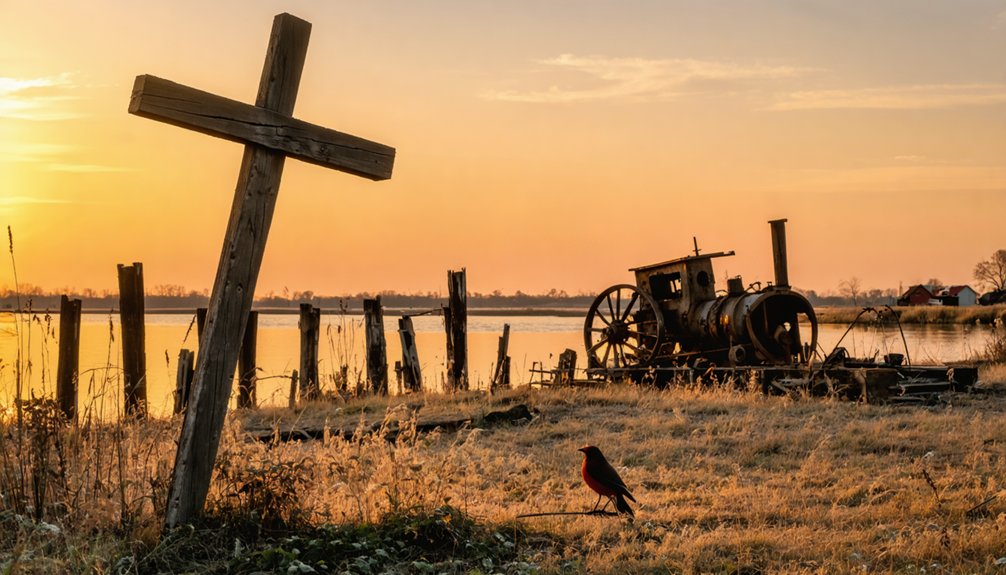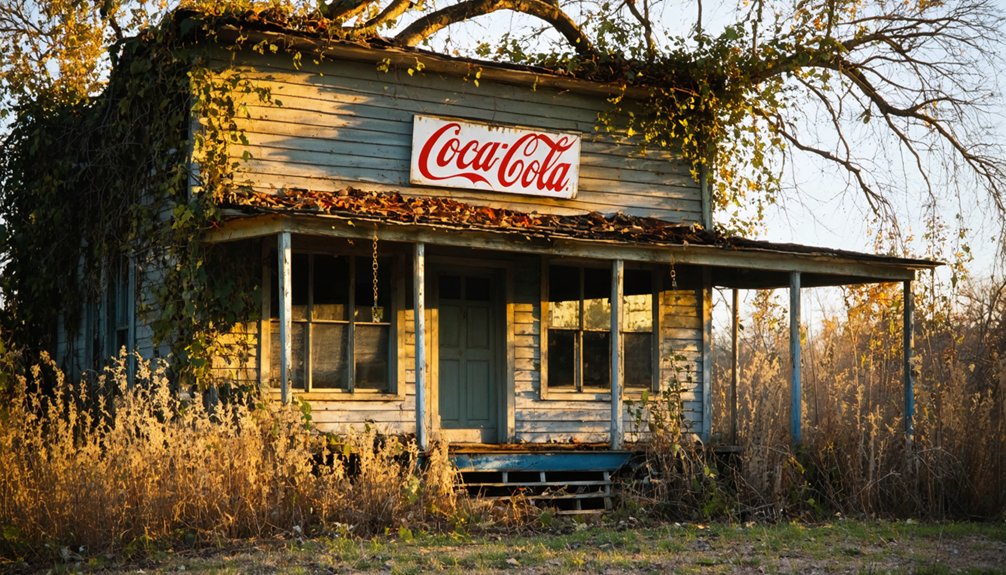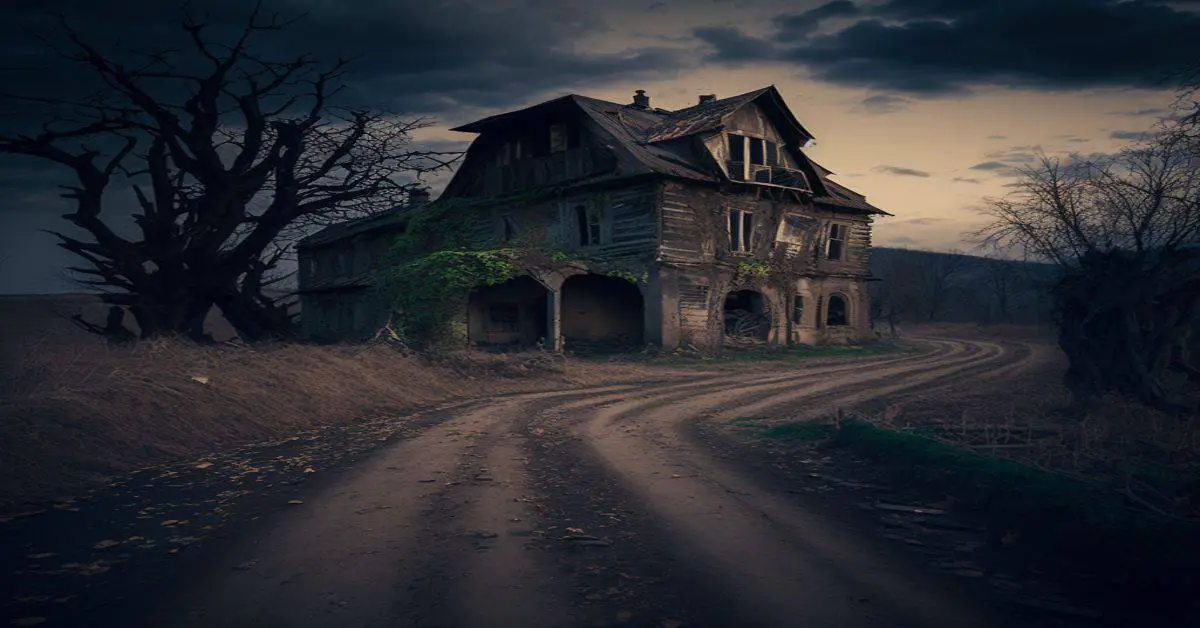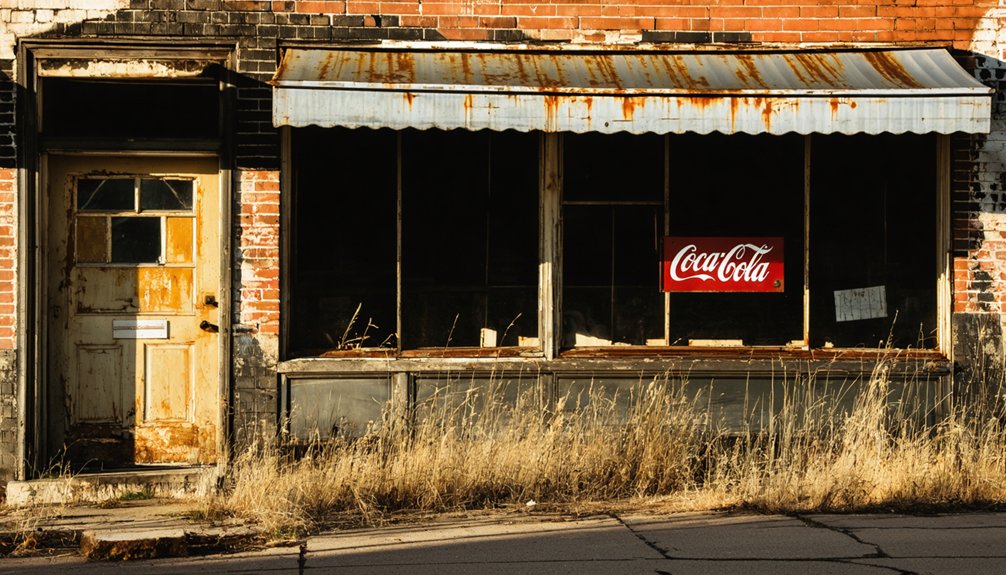If you’re curious about Griggsville Landing, you’ll find a fascinating ghost town that once thrived as an essential Illinois River trading post. Founded in 1822 by Garrett van Dusen, it flourished with steamboat traffic, warehouses, and a prominent lime kiln until the 1860s. The arrival of railroads, coupled with devastating floods and problematic Army Corps levees, forced residents to abandon their homes for nearby Valley City by 1877. The town’s limestone bluffs still guard countless untold stories of this lost river community.
Key Takeaways
- Established in 1822 as a river ferry crossing, Griggsville Landing evolved into a thriving commercial center with warehouses and steamboat trade.
- The arrival of railroads in the 1860s caused economic decline as merchants shifted from river to rail transportation.
- Severe flooding, worsened by Army Corps of Engineers’ levee construction, forced residents to relocate to Valley City by 1877.
- The limestone kiln, built in 1850, represents the town’s industrial heritage as one of Illinois’ best-preserved 19th-century kilns.
- The abandoned settlement now stands as a ghost town, marked by recurring floods and the remnants of its commercial past.
The Rise of a River Trading Hub
When Garrett van Dusen established a simple ferry crossing on the Illinois River in 1822, he couldn’t have known his modest operation would transform into one of west central Illinois’s crucial trading hubs. His basic ferry operations, using only canoes and guiding swimming horses across the water, laid the foundation for what would become a bustling port.
After Nimrod Phillips took over, the site evolved rapidly. By the 1830s, you’d have found steamboats regularly stopping to load and unload cargo, connecting local farmers to markets as far away as New Orleans. Among the port’s significant structures was a lime kiln from 1850 that supplied building materials for homes and bridges in the region.
The landing’s strategic position along the Illinois River made it perfect for agricultural commerce, linking the Great Lakes to the Mississippi River. A warehouse, boat repair yard, grist mill, and hotel soon sprouted up, turning this once-humble ferry crossing into a crucial commercial center. The site remained active until devastating floods in 1993 forced its complete abandonment.
Transportation Evolution and Economic Impact
The arrival of railroads in Pike County during the 1860s marked the beginning of the end for Griggsville Landing‘s prominence as a river trading post.
Railroads transformed Pike County in the 1860s, spelling doom for the once-thriving river trade at Griggsville Landing.
As tracks bypassed the landing in favor of Griggsville and Valley City, you’d have witnessed dramatic transportation shifts that transformed the region’s economic landscape.
The once-bustling steamboat traffic that carried your hogs, apples, and cattle to St. Louis and New Orleans dwindled by the 1870s.
The economic transformation was swift and unforgiving. When the U.S. Army Corps of Engineers constructed levees along the Illinois River, they altered flooding patterns that further crippled river commerce.
Your local lime kiln shut down, businesses closed, and families moved away.
The journey from New England to Griggsville Landing via Erie Canal routes had become obsolete.
The railroad’s promise of faster, more reliable transportation had sealed Griggsville Landing’s fate as another river town left behind by progress.
Nature’s Force: Environmental Challenges
If you’d visited Griggsville Landing in its final years, you’d have witnessed the devastating impact of the Army Corps of Engineers‘ levee system, which transformed annual river patterns into destructive floods that repeatedly ravaged the town’s structures.
The bluffs that once made the landing an ideal river port became a natural barrier trapping floodwaters, while the levees designed to protect agricultural lands ironically accelerated the settlement’s demise. Today, the historic lime kiln remains stand as one of the few preserved structures from this once-thriving steamboat stop.
Local accounts from the 1960s describe watching helplessly as each spring brought new floods that swept away more of the town’s remaining buildings, until even the hardiest residents were forced to abandon their homes. The town’s proximity to both the Mississippi and Illinois Rivers created ideal conditions for mosquitoes that would later plague the region.
Recurring River Flood Patterns
Living along the Illinois River meant accepting nature’s recurring challenge, as residents witnessed dramatic flood events stretching back to the early 1700s.
Despite efforts at flood prevention and river management, the waters kept rising, reshaping lives along its banks. Historical records from Lucien Edlen’s documentation show the devastating impact of major floods dating from 1725 to 1869. The 2019 flood event brought unprecedented challenges, with 145 days of sustained flooding.
You’d have witnessed these dramatic patterns:
- The river climbing well above its normal 9.2-foot stage to reach destructive flood levels of 14 feet or higher
- Floodwaters sweeping across farmlands and settlements with increasing frequency since 1998
- Extended periods of high water that could last for weeks, threatening homes and livelihoods
The river’s might has only grown stronger in recent years, with five of the ten highest flood crests occurring since 1998.
Modern communities face the same challenges their ancestors did, adapting to the river’s untamed power.
Levee Construction’s Ripple Effect
Building levees along the Illinois River in the early 20th century released devastating consequences for Griggsville Landing and its neighboring settlements.
You’d have seen how these flood control structures, built by the U.S. Army Corps of Engineers, simply shifted water problems downstream, creating what locals called “wrong side of the levee” communities.
The levee impacts hit Griggsville Landing’s core industries hard. Your local ice house and warehouse couldn’t survive the increased flooding, while commercial fishing and river agriculture became impossible to sustain. The Flood Control Act of 1938 further solidified the region’s flood protection priorities.
The flood redistribution transformed the environmental landscape, eroding soil and altering natural water patterns. You’d find native wildlife habitats diminishing as invasive species took hold.
Most tragically, you’d watch as your neighbors abandoned their homes, businesses shut down, and the historic community’s liveliness washed away with each new flood.
Bluffs and Natural Barriers
Along the Illinois River’s edge, dramatic limestone bluffs tower over what remains of Griggsville Landing, creating nature’s own fortress walls that have shaped life here for generations.
You’ll find these natural barriers have been both blessing and curse for settlers, protecting from harsh winds while presenting challenges through ongoing bluff erosion. Located less than a half-mile from Valley City, these rugged cliffs provided a strategic vantage point for river commerce. The town’s busy steamboat stop in the 1830s made it a crucial trading post along the river.
When you explore the river ecosystems here, you’ll discover:
- Deep ravines carved by centuries of water flow, revealing layers of ancient limestone
- Natural springs seeping through rock faces, creating unique microhabitats for rare plants
- Weathered caves and overhangs where generations of traders once sought shelter
These imposing bluffs continue their silent watch over the ghost town below, their crumbling faces a reflection of nature’s unstoppable force in reclaiming what was once here.
Cultural and Religious Significance

Religious heritage runs deep at Griggsville Landing, where multiple spiritual traditions converge at this historic Illinois River settlement.
You’ll find Zelph Mound, where Mormon leader Joseph Smith reported a vision of an ancient warrior’s remains, making this site significant to Mormon heritage. The area’s spiritual importance predates this event, with Hopewell culture burial mounds dating back to 100 BC.
At the base of Church Hollow Road, you’ll discover the remnants of a tiny Union Church, no bigger than a modern garage, where early settlers gathered for worship and community meetings since 1835.
Today, Mormon groups continue this tradition of communal gatherings through pilgrimages and clean-up efforts, while the local Historical Society preserves photographs and memories of this culturally rich river town.
Industrial Heritage: The Lime Kiln Legacy
Beyond the spiritual landmarks, the industrial heart of Griggsville Landing beat strongest at its limestone kiln, constructed in the mid-1850s. You can still witness this remarkable symbol of America’s industrial heritage, standing as one of Illinois’ best-preserved 19th-century kilns.
The lime production process was an intricate dance of heat and precision:
Manufacturing lime required a delicate ballet of temperature control and expert timing to achieve the perfect transformation.
- Workers stacked hardwood at the base and loaded limestone chunks through the top
- For 72 hours, temperatures soared to 1517°F, transforming raw stone into valuable quicklime
- After 12 hours of cooling, workers extracted the finished product for mortar, plaster, and whitewash
The kiln’s historical significance extends beyond its walls – it powered local construction, supported river trade, and embodied the entrepreneurial spirit that built Pike County before industrial giants changed everything by the 1870s.
The Path to Abandonment

In the late 1860s, you’d have witnessed the railroad’s arrival sounding the death knell for Griggsville Landing’s bustling river trade, as merchants and farmers redirected their goods to the new rail stations.
You couldn’t escape the crushing blow of annual flood cycles that repeatedly devastated local businesses and homes, especially after the Army Corps of Engineers constructed levees that intensified flooding in the area.
The final exodus occurred as families and businesses relocated to the higher ground of Valley City, established in 1877, leaving behind empty warehouses and abandoned docks that once marked Griggsville Landing’s prosperity.
Railroad’s Impact on Trade
While Griggsville Landing once thrived as a bustling river port, the arrival of the Wabash Railroad in 1877 marked the beginning of its rapid decline. The railroad’s efficiency revolutionized local commerce, offering faster and more reliable transportation than the seasonal uncertainties of river trade.
You’d have witnessed a dramatic economic shift as businesses abandoned the landing for the newly platted Valley City at the rail crossing.
The impact was swift and devastating:
- The once-vital steamboat stop became redundant as traders chose rail over river.
- Local industries like the lime kiln couldn’t compete with cheaper goods transported by rail.
- The landing’s hotel, boat yard, and grist mill shuttered as commerce shifted northward.
Devastating Annual Flood Cycles
After the railroad diverted commerce from Griggsville Landing, devastating floods delivered the final blow to the struggling settlement.
The Army Corps of Engineers’ flood management strategy backfired when their levee system along the Illinois River forced more water into Valley City’s low-lying areas. You’d have witnessed annual floods overwhelming homes and businesses, with water levels rising higher than ever before.
The community’s resilience was tested as flooding disrupted essential economic activities – from commercial fishing to livestock transport.
Record-breaking discharge events, some with 30-year recurrence intervals, repeatedly battered the town. Local accounts describe watching helplessly as floodwaters decimated ice harvesting operations and forced business closures.
The relentless cycle of flooding ultimately drove residents away, transforming a once-thriving river port into a ghost town.
Relocation to Valley City
From the ashes of Griggsville Landing’s decline emerged a new settlement called Valley City, founded in 1877 by Wallace Parker near the old Phillips’ Ferry crossing.
As the railroad’s influence grew, you’d have witnessed a dramatic population migration away from the river landing towards this promising rail hub.
The economic opportunities in Valley City proved irresistible to former Griggsville Landing residents, offering:
- Strategic railroad access for shipping local produce to Chicago markets
- Thriving businesses including taverns, grocery stores, and a hotel
- Bustling agricultural operations with apple peeling plants and cider mills
The post office’s relocation from Griggsville Landing to Valley City symbolized this definitive shift in commercial power.
Workers flocked to Valley City’s orchards, establishing a vibrant agricultural economy that would sustain the community until devastating floods began taking their toll.
Frequently Asked Questions
Are There Any Remaining Residents Living Near Griggsville Landing Today?
You’ll find current residents concentrated in nearby communities like Griggsville proper, with around 1,028 people living within commuting distance, though not directly at the abandoned landing site itself.
What Happened to the Original Buildings From the Steamboat Landing?
You won’t find most of those abandoned structures today – they vanished when the town died in the 1870s. Only the incredibly well-preserved lime kiln, built around 1850, survives for historical preservation.
Can Visitors Legally Access the Griggsville Landing Site?
You can legally visit the ghost town’s public areas, including the lime kiln, during daylight hours. Just follow state visitor regulations and avoid private property while exploring the accessible grounds.
Were There Any Notable Crimes or Accidents During the Town’s Peak?
You won’t find documented crime history or tragic accidents from historical sources. While river landings were naturally hazardous places, there aren’t any specific recorded incidents during the town’s bustling period.
Did Any Famous Historical Figures Visit Griggsville Landing?
Mormon leader Joseph Smith’s visit is the only famous historical figure you’ll find in the records. He claimed a significant vision at Zelph Mound, making this his most notable documented appearance.
References
- https://kids.kiddle.co/Griggsville_Landing
- https://genealogytrails.com/ill/pike/ghost.html
- https://drloihjournal.blogspot.com/2018/01/lost-towns-of-illinois-griggsville-landing-illinois.html
- https://www.youtube.com/watch?v=93k0qtvzkn4&vl=en-US
- https://myfamilytravels.com/illinois-river-towns-locals-say-lost-their-soul/
- https://evendo.com/locations/illinois/illinois-river-valley/landmark/griggsville-landing-lime-kiln-historic-site
- https://www.heraldtimesonline.com/story/lifestyle/home-garden/2021/01/15/some-illinois-ghost-towns/43846097/
- https://kids.kiddle.co/Griggsville_Landing_Lime_Kiln
- https://en.wikipedia.org/wiki/Griggsville_Landing
- https://genealogytrails.com/ill/pike/citygriggsville.html



